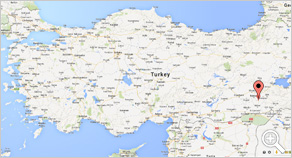HASANKEYF

Hasankeyf is an ancient city, located on the shores of the Tigris River in the Batman province of southeastern Turkey. It was a strategic spot on the route from Upper Mesopotamia to Anatolia and a staging point on the Silk Road. The history of the old town goes back 10,000 years. In 363, the Romans built two fortresses in the area. The city became the Byzantine bishopric of Cephe in the fifth century. After the Arabs incursions in c. 640, the city was called as “Hisn Kayfa” (rock fortress), which later changed to “Hasankeyf.”
After the Battle of Manzikert in 1071 between Byzantine and Seljuk forces, large parts of Anatolia and northern Mesopotamia were controlled by the Seljuks. In AH 495 (1101/1102) the Seljuk sultan Rukn ad-Dīn Barkiyāruq granted Hisn Kayfa as a timar (fief) to the Artukids. As a principality, Hasankeyf was ruled by sultans of Hasankeyf Beylik until 1232, when the Ayyubids invaded Hasankeyf and took over the control from the Artukids. The Ayyubids continued to rule the principality of Hasankeyf and managed to remain an autonomous entity, independent of the Mongol Ilkhanate, which ruled northern Mesopotamia until the 1330s. In the fourteenth century, the Ayyubids rebuilt the castle of Hisn Kayfa, which served as their stronghold as vassals of Mamluks and Dulkadirids until they were supplanted by the Ottoman Empire in 1517. In 1460-1482 Hasankeyf was under the control of the Ak Koyunlu.
The area of Hasankeyf was declared an archaeological site in 1980. Hasankeyf is divided into three-parts: the Upper City (or the Citadel), the Lower City and the Opposite Side. The Citadel is located on a flat structure up on a cliff situated about 100 meters from the river. It has been used as a residential area for centuries, with its 4000 caves and the remains of the Ulu Mosque, built by Ayyubid Sultan el Melik el-Adil Muciruddin Muhammed in 1325, and Small and Great Castles, built into the rock. In the Lower City, one of the most important remaining structures is the El-Rızk Mosque, built on the banks of the river in 1409 by architects Muhammed and Ömer, who were commissioned by the Ayyubid sultan Süleyman. Its impressive 30-meter high minaret has remained intact. The Old Tigris Bridge, located right in the middle of the river, was considered the largest bridge built in the Middle Ages. The bridge was built by the Artukids and rebuilt during the period of the Ayyubids in 1349. The middle vault was built of wood to enable its removal in order to prevent enemies from entering the city during attacks. The most important monument on the opposite side of the river is the Mausoleum of Zeynel Bey, son of the Sultan Uzun Hasan of the Ak Koyunlu period. This tomb is one of the only examples left in Anatolia of the classical architectural decoration dominant in the fourteenth century.
The area of Hasankeyf is threatened with disappearance due to the Ilısu Dam construction project, scheduled for completion in 2015. To protect the archaeological site of Hasankeyf, many activists are protesting against allowing this area to be submerged under water.
Some selected examples (please click on pictures to enlarge):








